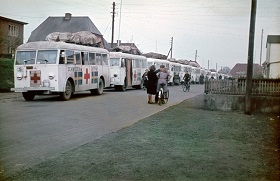The fates of Sweden, Norway and Denmark during the Second World War were different. Sweden opted for neutrality, whereas Denmark and Norway fell victims to Nazi aggression. Each Scandinavian nation has its own historical memory of the events that took place in those years. And they celebrate the end of the war on different dates: on May 5, Denmark celebrates a national holiday associated with the liberation of the country from its Nazi occupants; and Norwegians celebrate Liberation Day on May 8. Swedish people celebrate the liberation of Scandinavia from the Nazis on May 7 as part of its unofficial Peace Day.
The fates of Sweden, Norway and Denmark during the Second World War were different. Sweden opted for neutrality, whereas Denmark and Norway fell victims to Nazi aggression. Each Scandinavian nation has its own historical memory of the events that took place in those years. And they celebrate the end of the war on different dates: on May 5, Denmark celebrates a national holiday associated with the liberation of the country from its Nazi occupants; the majority of the Danish territory was liberated by British troops on May 4, 1945; and Norwegians celebrate Liberation Day on May 8, the date on which the five-year Nazi occupation of the Kingdom formally came to an end. Sweden did not participate in the war; nevertheless, Swedish people celebrate the liberation of Scandinavia from the Nazis on May 7 as part of its unofficial Peace Day.
Denmark and Norway celebrated the 70th anniversary of their liberation from the Nazi occupants at the state level on May 4. Queen Margrethe II of Denmark laid a wreath at the graves of members of the Resistance in the presence of Prime Minister Helle Thorning-Schmidt. On the same day, Frederik and Mary, the Crown Prince and Princess of Denmark took part in a ceremonial service at a local cathedral. Festive events were organized in 16 cities across the country.
The following day, church bells rang to celebrate the anniversary. Seventy years ago, bells rang to herald the coveted liberation of Denmark.
The stearin candle became the main symbol of the holiday, a sort of “Danish St. George Ribbon.” After the radio announcement was made on May 4, 1945 about the landing of British troops, the Danish people removed covers (used for blackout) from their windows and placed candles to mark the end of the war. Since then, candles are lit in Danish houses every year on the evening of May 4. This tradition is not as popular as it used to be; however, it still reminds the Danish people of the joyful day 70 years ago.
The Russian and Danish people share a respectful attitude towards the events of the Second World War and its veterans, and both condemn Nazism. However, the practice of dividing the countries of the anti-Hitler coalition into “good” and “bad” that dates from the years of the Cold War has left a nasty scar on the 70th anniversary of the liberation. Local newspapers and television shows once again featured stories about the “Soviet military occupation of the island of Bornholm”, which sounded a lot like the rhetoric popular in the Baltic region. School pupils learn from the website run by the Danish Ministry of Education that, after the announcement that the main Wehrmacht force in Denmark had surrendered, peace came to Bornholm, maintained by members of the Resistance and German patrols. But then “disaster struck”, as Soviet planes bombarded the island heavily, following which the Red Army occupied the island until the spring of 1946. Bornholm was, therefore, “completely” liberated only when the Soviet “occupants” left, a fact reiterated by the Danish television channel TV2. This rhetoric contradicts the fact that there is a three-metre-tall stele in Bornholm commemorating the “occupants” with the inscription “Eternal Glory to Russian Heroes Killed in Battles with German Occupants”.
In Norway, the red partisans from Kiberg, Finnmark, became hostages of the Cold War. In the autumn of 1940, after Norway had become occupied by German troops, most of the Kiberg population fled to the USSR. Some of them were sent to the rear, and some were trained and then sent back to Norway for sabotage attacks. Together with Soviet troops, red Norwegian partisans participated in the liberation of Finnmark in autumn 1944; however, their fate was sad – in conditions of the Cold War, the former guerrillas recruited in the USSR were not considered heroes, and the general attitude to them remained cautious. The authorities as good as forgot about them, those who had fought against the Nazis. It was 40 years before historical justice would be restored, when a museum and memorial were unveiled in Kiberg celebrating the Finnmark partisans.
The ideas dating from the Cold War are not as popular in Norway as they are in Denmark, and red partisans were remembered on the 70th anniversary of the liberation of the Kingdom. On May 8, 2015, a total of 21 cannon shots were fired at Vardøhus Fortress to celebrate the Finnmark partisans, including residents of Kiberg.
Despite criticism, a monument was erected in Oslo dedicated to Osvald, the most active communist group of the Norwegian Resistance, featuring a hammer smashing a swastika.
The graves of one hundred thousand Soviet prisoners of war who died in the north of Norway while building various facilities for occupants, including bunkers for submarines in Trondheim and Bergen, represent another regrettable legacy of Cold War. They were buried in communal graves, forsaken by society, just as the Kiberg guerrillas were. Even darker is the Ministry of Defence’s 1951 secret operation, codenamed Asphalt, to transfer the remains of 9,000 people to a single grave. However, historical justice was eventually restored when in 2008, Norway set about identifying the remains with the use of Soviet and German archives.
Since quite recently, May 8 has been a double celebration in Norway – Liberation Day and Veterans Day, which serves as a remembrance to those who participated in military operations outside the country at various times. Many Norwegians wonder whether it is right to remember members of the Norwegian Resistance and participants in recent foreign Norwegian campaigns such as the one in Afghanistan.
On May 8, military ceremonies featuring awards presentations for veterans were organized in many Norwegian venues, including near the monument to the Soviet Liberator Soldier in Kirkenes. On the same day, King Harald V of Norway and Prime Minister Erna Solberg attended a commemorative ceremony at Akershus Fortress in Oslo. Nothing of this kind could ever have happened in Sweden, where the liberation of Scandinavia and the end of the Second World War are both unofficial holidays. On May 8, 2015, the Radio Sweden website posted a series of historical facts about the Second World War with detailed accounts of crowds of people in downtown Stockholm celebrating the first instrument of surrender signed by Germany on April 7, 1945.
Why is there no official holiday in Sweden to celebrate the end of hostilities? Although the country did impose martial law, Sweden formally did not fight in the war, remaining one of the few neutral countries.
The perception of the events of the Second World War in Sweden differs dramatically from that in Russia. For regular Swedish people, the heroes of the war include Count Folke Bernadotte, who brought numerous prisoners of war from concentration camps home in white Red Cross buses; and the diplomat Raoul Wallenberg, who saved 100,000 Jews. The Swedish people are proud of the fact that they offered refuge to Finnish children of war and Norwegian and Baltic refugees.
However, there are dark pages in Sweden’s history of the Second World War as well. Besides offering refuge to Finnish escapees, Sweden officially provided military assistance to Finland, sending almost 10,000 volunteers to fight against Soviet troops. The specific Swedish neutrality benefitted Germany, which enjoyed the sympathy of Swedish elites. For instance, during the period 1940–1944, Swedish railways transported 2.1 million German soldiers, in direct contradiction of the Hague Convention. It is building on the capital received from Germany in exchange for Swedish iron ore that the Swedish authorities managed to build their legendary welfare state of Folkhemmet. Incidentally, the Swedish authorities have not apologized to the relatives of the communists whom the Swedish coalition cabinet sent to labour camps in the north of the country during the Second World War “just in case.”
On the other hand, Sweden commemorates the Soviet soldiers who returned from Finnish and Norwegian prison camps via Sweden. In 1999, a commemorative sign was installed at the initiative of local residents in Skinnskatteberg, where Red Army soldiers lived before being sent back to the USSR. A similar sign will soon be placed in Karlsvik through the efforts of the Russian–Swedish Sputnik organization.
In this day and age, when Scandinavian countries have chosen to actively criticize Russia, it is of crucial importance to find common ground, such as the historical memory of the events of May 1945.









